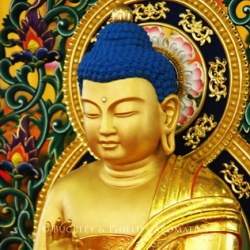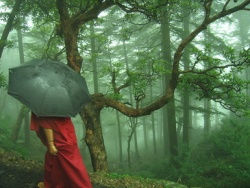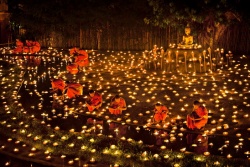Difference between revisions of "Isipatana"
| Line 1: | Line 1: | ||
[[File:2707.jpg|thumb|250px|]] | [[File:2707.jpg|thumb|250px|]] | ||
<poem> | <poem> | ||
| − | 1. Isipatana.-An open [[space]] near [[Benares]], the site of the famous [[Migadāya]] or [[Deer Park]]. It was eighteen leagues from [[Uruvelā]], and when [[Gotama]] gave up his austere penances his friends, the [[Pañcavaggiya]] [[monks]], left him and went to [[Isipatana]] (J.i.68). After his [[Enlightenment]] The [[Buddha]], leaving [[Uruvela]], joined them in [[Isipatana]], and it was there that he [[preached]] his [[first sermon]], the [[Dhammacakkappavattana]] [[Sutta]], on the [[full-moon day]] of [[āsālha]]. Vin.i.10f.; on this occasion 80 [[kotis]] of [[Brahmas]] and innumerable [[gods]] [[attained]] the [[comprehension]] of the [[Truth]] (Mil.30); (130 [[kotis]] says Mil.350). The Lal. (528) gives details of the stages of this journey. The [[Buddha]], having no [[money]] with which to pay the ferryman, crossed the [[Ganges]] through the [[air]]. When [[Bimbisāra]] [[heard]] of this, he abolished the toll for ascetics. | + | 1. Isipatana.-An open [[space]] near [[Benares]], the site of the famous [[Migadāya]] or [[Deer Park]]. It was eighteen leagues from [[Uruvelā]], and when [[Gotama]] gave up his austere penances his friends, the [[Pañcavaggiya]] [[monks]], left him and went to [[Isipatana]] (J.i.68). After his [[Enlightenment]] The [[Buddha]], leaving [[Uruvela]], joined them in [[Isipatana]], and it was there that he [[preached]] his [[first sermon]], the [[Dhammacakkappavattana]] [[Sutta]], on the [[full-moon day]] of [[āsālha]]. Vin.i.10f.; on this occasion 80 [[kotis]] of [[Brahmas]] and innumerable [[gods]] [[attained]] the [[comprehension]] of the [[Truth]] (Mil.30); (130 [[kotis]] says Mil.350). The Lal. (528) gives details of the stages of this journey. The [[Buddha]], having no [[money]] with which to pay the ferryman, crossed the [[Ganges]] through the [[air]]. When [[Bimbisāra]] [[heard]] of this, he abolished the toll for [[ascetics]]. |
| + | |||
| + | [[Isipatana]]: See; "[[Sarnath]]." [[Name]] for [[Saranth]] used in [[Pali Canon]]. | ||
| + | |||
| + | The [[Buddha]] spent his first [[rainy season]] (BuA., p.3).All the [[Buddhas]] {{Wiki|preach}} their [[first sermon]] at the [[Migadāya]] in [[Isipatana]]; it is one of the four [[avijahitatthānāni]] ([[unchanging]] spots), the others [[being]] the [[Bodhi]]-[[pallanka]], the spot at the gate of [[Sankassa]], where The [[Buddha]] first touches the [[earth]] on his return from [[Tāvatimsa]], and the site of the bed in the [[Gandhakuti]] in [[Jetavana]] (BuA.247; DA.ii.424).Isipatana is mentioned by The [[Buddha]] as one of the four places of [[pilgrimage]] which his devout followers should visit (D.ii.141).Isipatana was so-called because [[sages]], on their way through the [[air]] (from the [[Himalayas]]), alight here or start from here on their aerial flight (isayo [[ettha]] nipatanti uppatanti cāti-Isipatanam).The [[Migadāya]] was so-called because {{Wiki|deer}} were allowed to roam about there unmolested.Pacceka [[Buddhas]], having spent seven days in [[contemplation]] in the Gandhamā[[Dana]], bathe in the [[Anotatta Lake]] and come to the habitations of men through the [[air]], in search of [[alms]]. | ||
| + | |||
| + | They descend to [[earth]] at [[Isipatana]] (MA.i.387; AA.i.347 adds that [[sages]] also held the [[uposatha]] at Isipatana).Sometimes the [[Pacceka]] [[Buddhas]] come to [[Isipatana]] from [[Nandamūlaka-pabbhāra]] (MA.ii.1019; PsA.437-8).Several other incidents connected with The [[Buddha]], besides the preaching of the [[first sermon]], are mentioned as having taken place in [[Isipatana]]. Here it was that one day at dawn [[Yasa]] came to The [[Buddha]] and became an [[Arahant]] (Vin.i.15f). It was at [[Isipatana]], too, that the rule was passed prohibiting the use of sandals made of talipot leaves (Vin.i.189). On another occasion when The [[Buddha]] was staying at [[Isipatana]], having gone there from [[Rājagaha]], he instituted rules forbidding the use of certain kinds of flesh, including [[human]] flesh (Vin.i.216ff.; the rule regarding [[human]] flesh was necessary because Suppiyā made broth out of her own flesh for a sick [[Monk]]). Twice, while The [[Buddha]] was at [[Isipatana]], [[Māra]] visited him but had to go away discomfited (S.i.105f). | ||
| + | |||
[[File:6yzo.jpg|thumb|250px|]] | [[File:6yzo.jpg|thumb|250px|]] | ||
Besides the [[Dhammacakkappavattana]] [[Sutta]] mentioned above, several other [[suttas]] were [[preached]] by The [[Buddha]] while staying at [[Isipatana]], among them | Besides the [[Dhammacakkappavattana]] [[Sutta]] mentioned above, several other [[suttas]] were [[preached]] by The [[Buddha]] while staying at [[Isipatana]], among them | ||
| Line 8: | Line 15: | ||
the [[Rathakāra]] or Pacetana [[Sutta]] (A.i.110f), the two Pāsa [[Suttas]] (S.i.105f), the [[Samaya]] [[Sutta]] (A.iii.320ff), the Katuviya [[Sutta]] (A.i.279f.), a {{Wiki|discourse}} on the [[Metteyyapañha]] of the [[Parāyana]] (A.iii.399f), and the [[Dhammadinna]] [[Sutta]] (S.v.406f), [[preached]] to the distinguished [[layman]] [[Dhammadinna]], who came to see The [[Buddha]].Some of the most {{Wiki|eminent}} members of [[The Sangha]] seem to have resided at [[Isipatana]] from [[time]] to [[time]]; among recorded conversations at [[Isipatana]] are several between [[Sāriputta]] and [[Mahākotthita]] (S.ii.112f;iii.167f;iv.162f; 384ff), and one between [[Mahākotthita]] and [[Citta]]-[[Hatthisāriputta]] (A.iii.392f).Mention is made, too, of a {{Wiki|discourse}} in which several [[monks]] staying at [[Isipatana]] tried to help [[Channa]] in his difficulties (S.iii.132f).According to the [[Mahāvamsa]], there was a large [[community of monks]] at [[Isipatana]] in the second century B.C. For, we are told that at the foundation {{Wiki|ceremony}} of the [[Mahā Thūpa]] in [[Anurādhapura]], twelve thousand [[monks]] were {{Wiki|present}} from [[Isipatana]] led by the Elder [[Dhammasena]] (Mhv.xxix.31). | the [[Rathakāra]] or Pacetana [[Sutta]] (A.i.110f), the two Pāsa [[Suttas]] (S.i.105f), the [[Samaya]] [[Sutta]] (A.iii.320ff), the Katuviya [[Sutta]] (A.i.279f.), a {{Wiki|discourse}} on the [[Metteyyapañha]] of the [[Parāyana]] (A.iii.399f), and the [[Dhammadinna]] [[Sutta]] (S.v.406f), [[preached]] to the distinguished [[layman]] [[Dhammadinna]], who came to see The [[Buddha]].Some of the most {{Wiki|eminent}} members of [[The Sangha]] seem to have resided at [[Isipatana]] from [[time]] to [[time]]; among recorded conversations at [[Isipatana]] are several between [[Sāriputta]] and [[Mahākotthita]] (S.ii.112f;iii.167f;iv.162f; 384ff), and one between [[Mahākotthita]] and [[Citta]]-[[Hatthisāriputta]] (A.iii.392f).Mention is made, too, of a {{Wiki|discourse}} in which several [[monks]] staying at [[Isipatana]] tried to help [[Channa]] in his difficulties (S.iii.132f).According to the [[Mahāvamsa]], there was a large [[community of monks]] at [[Isipatana]] in the second century B.C. For, we are told that at the foundation {{Wiki|ceremony}} of the [[Mahā Thūpa]] in [[Anurādhapura]], twelve thousand [[monks]] were {{Wiki|present}} from [[Isipatana]] led by the Elder [[Dhammasena]] (Mhv.xxix.31). | ||
[[File:60968.jpg|thumb|250px|]] | [[File:60968.jpg|thumb|250px|]] | ||
| − | [[Hiouen Thsang]] (Beal: Records of the {{Wiki|Western}} [[World]], ii.45ff ) found, at [[Isipatana]], fifteen hundred [[monks]] studying the [[Hīnayāna]]. In the enclosure of the [[Sanghārāma]] was a [[vihāra]] about two hundred feet high, strongly built, its roof surmounted by a golden figure of the mango. In the centre of the [[vihāra]] was a [[Life]]-size statue of The [[Buddha]] turning the [[wheel]] of the Law. To the south-west were the remains of a stone [[Stupa]] built by [[Asoka]]. The Divy. (389-94) mentions [[Asoka]] as intimating to [[Upagupta]] his [[desire]] to visit the places connected with The [[Buddha]]'s [[activities]], and to erect thupas there. [[Thus]] he visited [[Lumbinī]], [[Bodhimūla]], [[Isipatana]], [[Migadāya]] and [[Kusinagara]]; this is confirmed by [[Asoka's]] lithic records, e.g. Rock {{Wiki|Edict}}, viii.In front of it was a stone pillar to mark the spot where The [[Buddha]] [[preached]] his [[first sermon]]. Near by was another [[Stupa]] on the site where the [[Pañcavaggiyas]] spent their [[time]] in [[Meditation]] before The [[Buddha]]'s arrival, and another where five hundred [[Pacceka]] [[Buddhas]] entered [[Nibbāna]]. Close to it was another building where the {{Wiki|future}} [[Buddha]] [[Metteyya]] received assurance of his becoming a [[Buddha]].[[Hiouen Thsang]] quotes the [[Nigrodhamiga]] [[Jātaka]] (J.i.145ff) to account for the origin of the [[Migadāya]]. According to him the [[Deer Park]] was the {{Wiki|forest}} gifted by the [[king]] of [[Benares]] of the [[Jātaka]], where the {{Wiki|deer}} might wander unmolested.According to the Udapāna [[Jātaka]] (J.ii.354ff ) there was a very {{Wiki|ancient}} well near [[Isipatana]] which, in The [[Buddha]]'s [[time]], was used by the [[monks]] living there.In {{Wiki|past}} ages [[Isipatana]] sometimes retained its own [[name]], E.g., in the [[time]] of [[Phussa Buddha]] (Bu.xix.18), [[Dhammadassī]] (BuA.182) and [[Kassapa]] (BuA.218). [[Kassapa]] was born there (ibid., 217).But more often [[Isipatana]] was known by different names (for these names see under those of the different [[Buddhas]]). [[Thus]] in [[Vipassī's]] [[time]] it was known as [[Khema]]-uyyāna. It is the {{Wiki|custom}} for all [[Buddhas]] to go through the [[air]] to [[Isipatana]] to {{Wiki|preach}} their [[first sermon]]. [[Gotama]], however, walked all the way, eighteen leagues, because he knew that by so doing he would meet [[Upaka]], the [[Ajivaka]], to whom he could be of service (DA.ii.471).Isipatana is identified with the {{Wiki|modern}} Saranath, six {{Wiki|miles}} from [[Benares]]. Cunningham (Arch. Reports, i. p. 107) found the [[Migadāya]] represented by a fine [[wood]], covering an area of about half a mile, extending from the great tomb of Dhammek on the [[north]] to the Chaukundi mound on the south.2. Isipatana.-A [[monastery]] built by [[Parakkamabāhu]] I. in the suburb Rājavesibhujanga, of Pulatthipura. Cv.lxxviii.79; but see lxxiii.151-5 and Cv. Trs.ii.18, n.3. | + | [[Hiouen Thsang]] (Beal: Records of the {{Wiki|Western}} [[World]], ii.45ff ) found, at [[Isipatana]], fifteen hundred [[monks]] studying the [[Hīnayāna]]. In the enclosure of the [[Sanghārāma]] was a [[vihāra]] about two hundred feet high, strongly built, its roof surmounted by a golden figure of the mango. In the centre of the [[vihāra]] was a [[Life]]-size statue of The [[Buddha]] turning the [[wheel]] of the Law. To the south-west were the remains of a stone [[Stupa]] built by [[Asoka]]. The Divy. (389-94) mentions [[Asoka]] as intimating to [[Upagupta]] his [[desire]] to visit the places connected with The [[Buddha]]'s [[activities]], and to erect thupas there. |
| + | |||
| + | [[Thus]] he visited [[Lumbinī]], [[Bodhimūla]], [[Isipatana]], [[Migadāya]] and [[Kusinagara]]; this is confirmed by [[Asoka's]] lithic records, e.g. Rock {{Wiki|Edict}}, viii.In front of it was a stone pillar to mark the spot where The [[Buddha]] [[preached]] his [[first sermon]]. Near by was another [[Stupa]] on the site where the [[Pañcavaggiyas]] spent their [[time]] in [[Meditation]] before The [[Buddha]]'s arrival, and another where five hundred [[Pacceka]] [[Buddhas]] entered [[Nibbāna]]. Close to it was another building where the {{Wiki|future}} [[Buddha]] [[Metteyya]] received assurance of his becoming a [[Buddha]].[[Hiouen Thsang]] quotes the [[Nigrodhamiga]] [[Jātaka]] (J.i.145ff) to account for the origin of the [[Migadāya]]. According to him the [[Deer Park]] was the {{Wiki|forest}} gifted by the [[king]] of [[Benares]] of the [[Jātaka]], where the {{Wiki|deer}} might wander unmolested.According to the Udapāna [[Jātaka]] (J.ii.354ff ) there was a very {{Wiki|ancient}} well near [[Isipatana]] which, in The [[Buddha]]'s [[time]], was used by the [[monks]] living there. | ||
| + | |||
| + | In {{Wiki|past}} ages [[Isipatana]] sometimes retained its own [[name]], E.g., in the [[time]] of [[Phussa Buddha]] (Bu.xix.18), [[Dhammadassī]] (BuA.182) and [[Kassapa]] (BuA.218). [[Kassapa]] was born there (ibid., 217).But more often [[Isipatana]] was known by different names (for these names see under those of the different [[Buddhas]]). [[Thus]] in [[Vipassī's]] [[time]] it was known as [[Khema]]-uyyāna. It is the {{Wiki|custom}} for all [[Buddhas]] to go through the [[air]] to [[Isipatana]] to {{Wiki|preach}} their [[first sermon]]. [[Gotama]], however, walked all the way, eighteen leagues, because he knew that by so doing he would meet [[Upaka]], the [[Ajivaka]], to whom he could be of service (DA.ii.471).Isipatana is identified with the {{Wiki|modern}} Saranath, six {{Wiki|miles}} from [[Benares]]. Cunningham (Arch. Reports, i. p. 107) found the [[Migadāya]] represented by a fine [[wood]], covering an area of about half a mile, extending from the great tomb of Dhammek on the [[north]] to the Chaukundi mound on the south.2. Isipatana.-A [[monastery]] built by [[Parakkamabāhu]] I. in the suburb Rājavesibhujanga, of Pulatthipura. Cv.lxxviii.79; but see lxxiii.151-5 and Cv. Trs.ii.18, n.3. | ||
</poem> | </poem> | ||
{{R}} | {{R}} | ||
Latest revision as of 19:15, 4 April 2014
1. Isipatana.-An open space near Benares, the site of the famous Migadāya or Deer Park. It was eighteen leagues from Uruvelā, and when Gotama gave up his austere penances his friends, the Pañcavaggiya monks, left him and went to Isipatana (J.i.68). After his Enlightenment The Buddha, leaving Uruvela, joined them in Isipatana, and it was there that he preached his first sermon, the Dhammacakkappavattana Sutta, on the full-moon day of āsālha. Vin.i.10f.; on this occasion 80 kotis of Brahmas and innumerable gods attained the comprehension of the Truth (Mil.30); (130 kotis says Mil.350). The Lal. (528) gives details of the stages of this journey. The Buddha, having no money with which to pay the ferryman, crossed the Ganges through the air. When Bimbisāra heard of this, he abolished the toll for ascetics.
Isipatana: See; "Sarnath." Name for Saranth used in Pali Canon.
The Buddha spent his first rainy season (BuA., p.3).All the Buddhas preach their first sermon at the Migadāya in Isipatana; it is one of the four avijahitatthānāni (unchanging spots), the others being the Bodhi-pallanka, the spot at the gate of Sankassa, where The Buddha first touches the earth on his return from Tāvatimsa, and the site of the bed in the Gandhakuti in Jetavana (BuA.247; DA.ii.424).Isipatana is mentioned by The Buddha as one of the four places of pilgrimage which his devout followers should visit (D.ii.141).Isipatana was so-called because sages, on their way through the air (from the Himalayas), alight here or start from here on their aerial flight (isayo ettha nipatanti uppatanti cāti-Isipatanam).The Migadāya was so-called because deer were allowed to roam about there unmolested.Pacceka Buddhas, having spent seven days in contemplation in the GandhamāDana, bathe in the Anotatta Lake and come to the habitations of men through the air, in search of alms.
They descend to earth at Isipatana (MA.i.387; AA.i.347 adds that sages also held the uposatha at Isipatana).Sometimes the Pacceka Buddhas come to Isipatana from Nandamūlaka-pabbhāra (MA.ii.1019; PsA.437-8).Several other incidents connected with The Buddha, besides the preaching of the first sermon, are mentioned as having taken place in Isipatana. Here it was that one day at dawn Yasa came to The Buddha and became an Arahant (Vin.i.15f). It was at Isipatana, too, that the rule was passed prohibiting the use of sandals made of talipot leaves (Vin.i.189). On another occasion when The Buddha was staying at Isipatana, having gone there from Rājagaha, he instituted rules forbidding the use of certain kinds of flesh, including human flesh (Vin.i.216ff.; the rule regarding human flesh was necessary because Suppiyā made broth out of her own flesh for a sick Monk). Twice, while The Buddha was at Isipatana, Māra visited him but had to go away discomfited (S.i.105f).
Besides the Dhammacakkappavattana Sutta mentioned above, several other suttas were preached by The Buddha while staying at Isipatana, among them
the Pañca Sutta (S.iii.66f),
the Rathakāra or Pacetana Sutta (A.i.110f), the two Pāsa Suttas (S.i.105f), the Samaya Sutta (A.iii.320ff), the Katuviya Sutta (A.i.279f.), a discourse on the Metteyyapañha of the Parāyana (A.iii.399f), and the Dhammadinna Sutta (S.v.406f), preached to the distinguished layman Dhammadinna, who came to see The Buddha.Some of the most eminent members of The Sangha seem to have resided at Isipatana from time to time; among recorded conversations at Isipatana are several between Sāriputta and Mahākotthita (S.ii.112f;iii.167f;iv.162f; 384ff), and one between Mahākotthita and Citta-Hatthisāriputta (A.iii.392f).Mention is made, too, of a discourse in which several monks staying at Isipatana tried to help Channa in his difficulties (S.iii.132f).According to the Mahāvamsa, there was a large community of monks at Isipatana in the second century B.C. For, we are told that at the foundation ceremony of the Mahā Thūpa in Anurādhapura, twelve thousand monks were present from Isipatana led by the Elder Dhammasena (Mhv.xxix.31).
Hiouen Thsang (Beal: Records of the Western World, ii.45ff ) found, at Isipatana, fifteen hundred monks studying the Hīnayāna. In the enclosure of the Sanghārāma was a vihāra about two hundred feet high, strongly built, its roof surmounted by a golden figure of the mango. In the centre of the vihāra was a Life-size statue of The Buddha turning the wheel of the Law. To the south-west were the remains of a stone Stupa built by Asoka. The Divy. (389-94) mentions Asoka as intimating to Upagupta his desire to visit the places connected with The Buddha's activities, and to erect thupas there.
Thus he visited Lumbinī, Bodhimūla, Isipatana, Migadāya and Kusinagara; this is confirmed by Asoka's lithic records, e.g. Rock Edict, viii.In front of it was a stone pillar to mark the spot where The Buddha preached his first sermon. Near by was another Stupa on the site where the Pañcavaggiyas spent their time in Meditation before The Buddha's arrival, and another where five hundred Pacceka Buddhas entered Nibbāna. Close to it was another building where the future Buddha Metteyya received assurance of his becoming a Buddha.Hiouen Thsang quotes the Nigrodhamiga Jātaka (J.i.145ff) to account for the origin of the Migadāya. According to him the Deer Park was the forest gifted by the king of Benares of the Jātaka, where the deer might wander unmolested.According to the Udapāna Jātaka (J.ii.354ff ) there was a very ancient well near Isipatana which, in The Buddha's time, was used by the monks living there.
In past ages Isipatana sometimes retained its own name, E.g., in the time of Phussa Buddha (Bu.xix.18), Dhammadassī (BuA.182) and Kassapa (BuA.218). Kassapa was born there (ibid., 217).But more often Isipatana was known by different names (for these names see under those of the different Buddhas). Thus in Vipassī's time it was known as Khema-uyyāna. It is the custom for all Buddhas to go through the air to Isipatana to preach their first sermon. Gotama, however, walked all the way, eighteen leagues, because he knew that by so doing he would meet Upaka, the Ajivaka, to whom he could be of service (DA.ii.471).Isipatana is identified with the modern Saranath, six miles from Benares. Cunningham (Arch. Reports, i. p. 107) found the Migadāya represented by a fine wood, covering an area of about half a mile, extending from the great tomb of Dhammek on the north to the Chaukundi mound on the south.2. Isipatana.-A monastery built by Parakkamabāhu I. in the suburb Rājavesibhujanga, of Pulatthipura. Cv.lxxviii.79; but see lxxiii.151-5 and Cv. Trs.ii.18, n.3.


